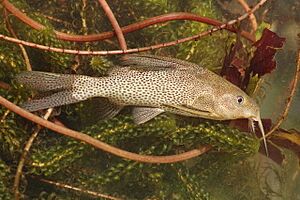Synodontis leopardinus facts for kids
Quick facts for kids Synodontis leopardinus |
|
|---|---|
 |
|
| Conservation status | |
| Scientific classification | |
| Genus: |
Synodontis
|
| Species: |
leopardinus
|
The leopard squeaker (scientific name: Synodontis leopardinus) is a special kind of upside-down catfish. It gets its name "leopard squeaker" because of its small black spots, just like a leopard! It also makes a squeaking sound when it's caught. This fish lives in rivers in Africa, including the Cunene, Okavango, and upper Zambezi Rivers. A scientist named Jacques Pellegrin first described this fish in 1914. He found the first ones in Zambia, in the Zambezi River. The name leopardinus means "leopard-like," which perfectly describes its spotted look.
Contents
About the Leopard Squeaker
Like other Synodontis fish, the leopard squeaker has a strong, bony head. This bony part goes all the way back to its first fin on its back. It also has a unique bony bump on its head called a humeral process.
Fish Features
The leopard squeaker has three pairs of barbels, which are like whiskers. One pair is on its upper jaw, and two pairs are on its lower jaw. These barbels help the fish feel around and find food. It has a large, soft fin near its tail, called an adipose fin. Its tail fin is shaped like a fork.
Spines for Safety
The front edges of the fins on its back and sides are very stiff. They are like strong spines! The fish can raise these spines straight out from its body. Once raised, they lock into place. This is a great way for the fish to protect itself from predators. It's hard for other animals to eat a fish with sharp, locked spines!
How It Eats
This fish has a special pad of teeth on the very front of its upper jaw. These teeth are short and shaped like tiny chisels. On its lower jaw, the teeth are different. They are attached to flexible stalks and look like "s" shapes or hooks. These teeth help the leopard squeaker grab and eat its food.
Size of the Fish
The leopard squeaker can grow up to about 19.6 centimeters (about 7.7 inches) long. This measurement is for its "standard length," which means from its nose to the base of its tail. Generally, female Synodontis fish are a little bigger than males of the same age.
Where It Lives and What It Does
In the wild, you can find the leopard squeaker in the Upper Zambezi and Okavango River systems. These rivers are in southern Africa.
What It Eats
Synodontis fish, including the leopard squeaker, are omnivores. This means they eat both plants and animals. They enjoy eating insect larvae, algae (a type of water plant), snails, clams, sponges, small crustaceans (like tiny shrimp), and even the eggs of other fish. They are not picky eaters!
Life Cycle and Reproduction
Scientists don't know everything about how most Synodontis fish reproduce. However, they do know that spawning (when fish lay eggs) likely happens during the flooding season. This is usually between July and October. During this time, male and female fish might swim together in pairs to lay their eggs. Young leopard squeakers grow very quickly in their first year. After that, their growth slows down as they get older.


